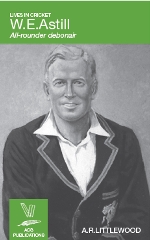WE Astill: All-rounder Debonaire
Martin Chandler |Published: 2014
Pages: 190
Author: Littlewood, Anthony
Publisher: ACS
Rating: 3 stars

Author Anthony Littlewood explains in the acknowledgments section at the end of this, his second book (the first was an earlier volume in the Lives in Cricket series about another Leicestershire all-rounder, JH King), that he began work on it as long ago as 1993. It is as well he did. Had he waited until now he would not, thanks to the inexorable march of Anno Domini, have been able to talk to more than a dozen cricketers who played with or against Ewart Astill, nor Colin Cowdrey who was coached by him at Tonbridge School. Without those contributions the book would, I have no doubt, have been a source of considerable disappointment.
The name of Ewart Astill will be familiar to those of us of a certain age who, in childhood and adolescence, were regular readers of Wisden, more particularly its records section. There were nine Tests for Astill, four in West Indies and five in South Africa, but those series are long forgotten and his work in them was steady rather than spectacular. The reasons we noticed Astill were his nine doubles, placing him fourth in the all-time list, the total of 2,432 career wickets that saw him at 14th in that table, and the fact he was one of only nine men to have completed a career double of 20,000 runs and 2,000 wickets. Had such a table been maintained the 33 year span in the First Class game would also have caught the eye.
Thus Astill is a man who should, given the vast bibliography the game of cricket has inspired, have a book about his life within that body of literature. Leicestershire cricket obviously has a place in Littlewood’s heart, but it is clear from his introduction he was not entirely convinced of the merits of his long term project. The difficulty he has arises out of Astill’s managing to avoid much in the way of controversy over his career and, playing for arguably the least “fashionable” of the First Class counties, not having participated in any famous matches.
To make matters worse for a biographer Astill seems to have been well-liked, with no real flaws in his character. He never married either, so there are no children or grandchildren to shed light on his personality or off field activities. That he was a highly accomplished billiards player is well known. Indeed he was, as would be expected from a professional cricketer, a decent all-round sportsman generally. More unexpectedly he was a musician of some talent as well, but such attributes do not of themselves make a compelling biography.
It is perhaps surprising in the circumstances that this book is one of the longer ones in the Lives in Cricket series, but Littlewood has pursued his project with such diligence his book runs to as many as 190 pages. There are lengthy chapters on Astill’s playing style. That on his bowling is particularly frustrating, as it leaves its reader little wiser at the end than he was at the beginning as to exactly what sort of bowler Astill was. The best conclusion would seem to be that he was essentially an off spinner, but a very versatile one.
The chapters in the book largely represent a faithful reconstruction of Astill’s playing career using contemporary newspaper reports and the writings of others as its foundation. It is not riveting stuff it has to be conceded, and the observations of all those former teammates and opponents who Littlewood managed to speak to in the 1990s are the only thing that tempts a reader not to skim read in the pursuit of more interesting material than bland descriptions of Astill’s cricket.
All in all I cannot claim to have greatly enjoyed reading WE Astill: All-rounder Debonaire, but I am still very glad I did, and am grateful to Anthony Littlewood for the fact I now know a great deal more about a man whose name I have noticed so often, but until now knew so little about.







Leave a comment